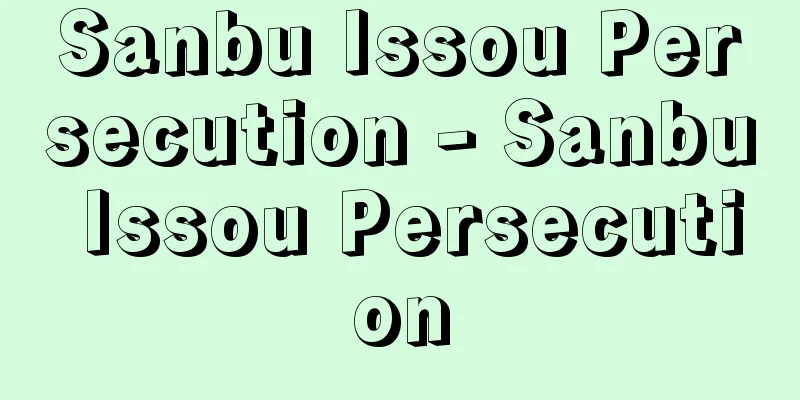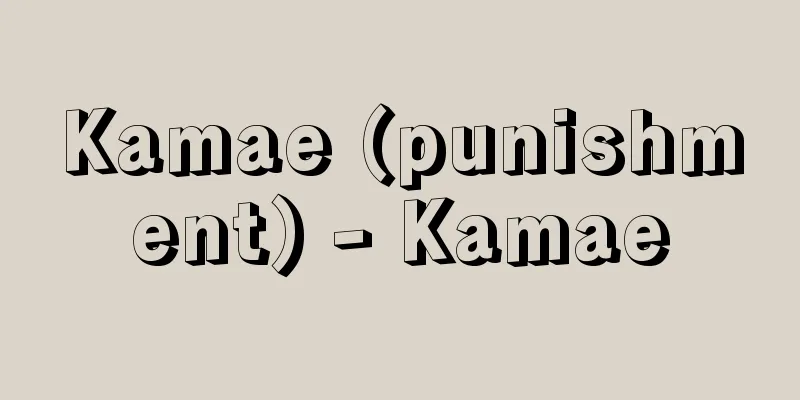Sanbu Issou Persecution - Sanbu Issou Persecution

|
This term was used by Buddhists to refer to the incidents of persecution of Buddhism carried out in the history of Chinese Buddhism by Emperor Taiwu of the Northern Wei dynasty, Emperor Wu of the Northern Zhou dynasty, Emperor Wuzong of the Tang dynasty (all known as the Three Wus), and Emperor Shizong (Izong) of the Later Zhou dynasty. (1) The Anti-Buddhist Movement in the Northern Wei Dynasty (446-452) Emperor Taiwu, who was of Xianbei descent, was influenced by the Han bureaucrat Cui Hao and the Taoist priest Kou Qianzhi and became inclined towards Taoism. He particularly adopted Cui Hao’s policies and forced the destruction of temples and pagodas throughout northern China, the return of monks and nuns to secular life, and the burning of Buddhist statues and sutra scrolls. (2) The Abolition of Buddhism in the Northern Zhou Dynasty (574-578) In the process of preparing for war against the neighboring Northern Qi Dynasty, Emperor Wu accepted the advice of the lay monk Wei Yuansong and others and decided to abolish Buddhism and Taoism, confiscate temples, and incorporate 3 million monks into the military and civilian population. The oppression was mainly directed at Buddhism, and some monks even risked their lives in protest, but in 577 it was also applied to the former territories of the defeated Northern Qi Dynasty. As a result, Buddhism in northern China was dealt a major blow and the idea of the Latter Days of the Law spread. (3) Anti-Buddhism in the Tang Dynasty (845-846) Commonly known as the "Anti-Buddhism in Kaichang." Emperor Wuzong, who was devoted to Taoism, listened to the advice of Taoist priests such as Zhao Guizhen, Deng Yuanqi, and Liu Xuanjing, and gradually strengthened his control over Buddhist sects. Finally, in the fifth year of the Kaichang era (845), he destroyed all temples, confiscated their property, and forced the monks and nuns to return to secular life, leaving only the minimum number of temples and monks and nuns necessary for state rituals. (4) The Later Zhou Dynasty (955-959) King Sejong reaffirmed the Buddhist management policy that had been implemented since the Tang Dynasty, and liquidated temples without Buddhist altars and privately-registered monks and nuns. Unlike the previous three times of abolishing Buddhism, this was not a fundamental abolition of Buddhism, as 2,694 temples and over 60,000 monks and nuns across the country were re-registered. A common feature of the four abolitions of Buddhism was that the increase in the non-productive population of monks and nuns and the expansion of temple estates became major problems for the nation's financial management. In addition, in the three abolitions of Buddhism except for the Late Zhou period, the powers of Taoism and Buddhism were competing with each other on the basis of Confucianism. [Tomomi Sato] [Reference] |Source: Shogakukan Encyclopedia Nipponica About Encyclopedia Nipponica Information | Legend |
|
中国仏教史上、北魏(ほくぎ)の太武帝、北周の武帝、唐の武宗(以上、三武)と後周(こうしゅう)の世宗(一宗)によって断行された仏教弾圧事件を仏教側からよんだことば。 (1)北魏の廃仏(446~452) 鮮卑(せんぴ)族出身の太武帝は漢人官僚崔浩(さいこう)と道士寇謙之(こうけんし)の影響を受けて道教に傾斜していき、とくに崔浩の方針を採用して、華北一帯の寺院堂塔の廃毀(はいき)、僧尼の還俗(げんぞく)、仏像経巻の焼却などを強行した。 (2)北周の廃仏(574~578) 武帝は隣国北斉(ほくせい)に対する臨戦体制を整える過程において、還俗僧衛元嵩(えいげんすう)らの提言をいれ、仏教と道教の廃棄を決定し、寺院は没収、300万の僧は軍民に編入された。弾圧は主として仏教に向けられ、これに死をもって抗議する僧もいたが、577年には、滅ぼした北斉の旧領内にも適用し、その結果、華北の仏教は大きな打撃を受け、末法思想が広まっていった。 (3)唐の廃仏(845~846) 通称「会昌(かいしょう)の廃仏」。道教に傾倒した武宗は、趙帰真(ちょうきしん)・鄧元起(とうげんき)・劉玄靖(りゅうげんせい)ら道士の提言をいれ、徐々に仏教教団に対する統制を強化し、ついには会昌5年(845)、国家祭祀(さいし)に必要な最小限度の寺院と僧尼を残して、その他の寺院の廃毀と財産没収、僧尼の還俗を断行した。 (4)後周の廃仏(955~959) 世宗は唐以来行われてきた仏教管理政策を再確認して、無額の寺や私度(しど)の僧尼を整理した。この廃仏は前3回の廃仏とは異なり、全国で2694の寺院と6万余の僧尼が改めて登録されるなど、根本的な廃仏ではなかった。 4回の廃仏に共通している点は、僧尼という非生産人口の増加と寺院荘園(しょうえん)の拡大が国家の財政運営上大きな問題となったことである。また、後周を除く三廃仏では、儒教を基本としたうえでの道教・仏教両勢力の角逐が認められる。 [佐藤智水] [参照項目] |出典 小学館 日本大百科全書(ニッポニカ)日本大百科全書(ニッポニカ)について 情報 | 凡例 |
>>: San Juan (English spelling)
Recommend
Pope - Alexander Pope
English poet. Born in London as the only son of a...
American League
One of the major leagues at the top of American p...
Panic - Panic (English spelling)
In economic terms, it means a panic. In social ps...
Kitayamadono
This refers to the villa that the third shogun, As...
Mein Kampf (English: My Struggle) German
Hitler's main work. After the Hitler Putsch (...
Scaridae
…a general term for marine fish of the Scaridae f...
Haga [town] - Haga
A former town in Shiso County, western Hyogo Prefe...
Yin and Yang in Harmony
〘Noun〙① The energy of yin and yang coming closer a...
Hay Point
…It is one of the tourist hubs of the Great Barri...
Onryōgoto - vengeful spirits
Kabuki acting and direction. It was popular during...
Comyn, John
[raw]? [Died] 1306 Scottish nobleman, Earl of Buch...
Sankt Anton (English spelling)
...1,802m above sea level. It has long been used ...
The Concordance of Umar
...With the establishment of Islam, they, along w...
Shichirigahama
This coast faces Sagami Bay in the southwest of K...
Izu Three Hot Springs
…This hot spring town developed around Shuzenji O...









